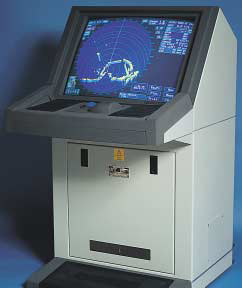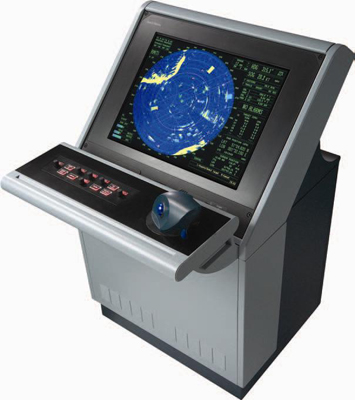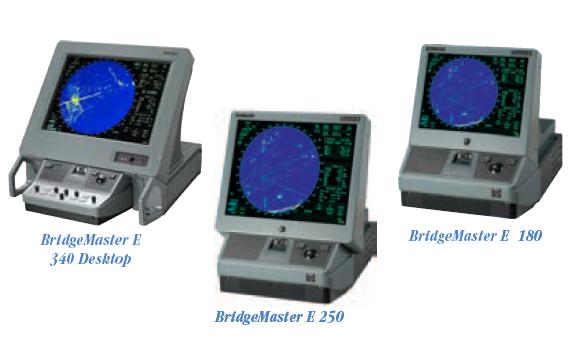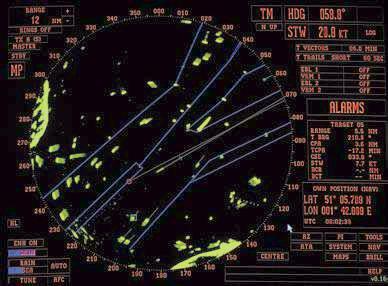 |
| X band navigation and S band search radars. (Photo by Jerry Proc) |
KEY RADAR SPECIFICATIONS
X Band (IEEE) navigation radar or I band (NATO)
Frequency - 9,410MHz
Wavelength - 3.1859 cm
Power - 25 kW
Pulse Repetition Rate - 375 to 3000 pps
Antenna - 2.4 metre wide turning at 24 rpm. It is 15.7 m (51 ft) above the waterline
Antenna Weight - 20 kg
Radiation Hazard (Radhaz) - 1.5 mS Band (IEEE) search radar or E,F band (NATO)
Frequency - 3,050 MHz
Wavelength - 9.8273 cm
Power 25 - kW
Pulse Repetition Rate - 375 to 3000 pps
Antenna - 4 metre wide turning at 22 rpm. It is 12.2 m (40 ft) above the waterline
Antenna Weight - 65 kg
Radiation Hazard (Radhaz) - 0.8 m
Closeup view of the S-band radar antenna. (Photo courtesy Rick Bungay)
The X band can be set to short pulse for distances less than 1.5 nm, medium pulse for distances from 3 to 24 nm or long pulse for distances beyond 24 nm. The X band has proven superior to the S band even at the longer ranges for which the S band was designed. Consequently, officers on the bridge using the Navigation radar often pick up contacts before the radar plotters in Operations do using the search radar.
 |
| Kelvin-Hughes Nucleus 3 6000A radar console. There are three Nucleus displays - two on the bridge and one in Operations. The forward bridge display is set to master for the X band while the after bridge display is set to slave for the S band while the Ops display is set to master for the S band. (Kelvin Hughes photo) |
NEW NAVIGATION RADAR FOR THE KINGSTON CLASS On April 16, 2008, it was announced that Northrop Grumman Corporation has won contracts to upgrade the navigation radars on the Canadian Navyís Kingston-Class maritime coastal defense vessels (MCDV) and Canadian Coast Guard vessels. The contracts, with a total value of more than $2 million (USD), were awarded to Northrop Grummanís Sperry Marine business unit.
SNC-Lavalin, the logistics support project manager for the MCDV program, has awarded contracts to Sperry Marine to replace the existing radar units on the 12 Kingston-Class ships. Each ship will be fitted with a suite of interswitched BridgeMaster E X-band and S-band radars with three 340-millimeter flat-screen displays. The installations will take place at the SNC-Lavalin facilities in Dartmouth, Nova Scotia, and Esquimalt, British Columbia.
Sperry Marine also recently received a three-year contract to upgrade the radars across the fleet of Canadian Coast Guard vessels with new BridgeMaster E 180, 250 and 340 radar sets.
 |
| Bridgemaster E Model 340 deckstand version. (Photo courtesy Sperry Marine/Northrup Grumman) |
 |
| Other versions of the Bridgemaster E series desktop displays. (Photo courtesy Sperry Marine/Northrup Grumman) |
 |
 |
| Displays can be customized by the operator. (Photo courtesy Sperry Marine/Northrup Grumman) | |
BridgeMaster E Series of Marine Radars - System ConfigurationAntennas:
X-Band (3 cm) Scanner (comprising antenna and turning unit)
Antenna Sizes: 4, 6 or 8 ft. (1.2, 1.8 or 2.4 m)
Transceiver Configurations: bulkhead or masthead mounted
Power 10 kW or 25 kW
Factory Fitted Options: Performance Monitor (required for IMO SOLAS vessels)S-Band (10 cm) Scanner (comprising antenna and turning unit)
Antenna Sizes: 9* or 12 ft. (2.7 or 3.6 m)
Transceiver Configurations: bulkhead or masthead mounted
Power 30 kW
Factory Fitted Options: Performance Monitor (required for IMO SOLAS vessels)
* The 9 ft. antenna is type approved for high speed craft only.
Circa: 2005Displays:
 |
| (Inage courtesy Sperry Marine/Northrup Grumman) |
The display type is the entire flat screen. The diameter which suffixes the model number is the size of the circular area displayed on the flat screen.
ARPA= Automatic Radar Plotting Aid
ATA= Automatic Tracking Aid
